Who Controls the User Experience? AMD’s Carrizo Thoroughly Tested
by Ian Cutress on February 4, 2016 8:00 AM ESTHow Hot is too Hot? Temperatures and Thermal Results
In a normal desktop computer, the goal is to complete the set of instructions the fastest and be able to dissipate the energy. With a mobile device however, where energy consumption as well as heat dissipation are both factors, it is no longer simply a race to complete the task the fastest, due to the fact that the efficiency of the task also comes in to play. There are some items that can be worked on over time at a more efficient performance per watt ratio, and not everything has to be done at lightning speed. There still comes a time when a program needs responsiveness, and the system is happy to pay an efficiency penalty in order to do so (lower performance/watt, but faster to react). With longer or sustained workloads, dealing with the excess energy lost as heat becomes a big factor, and there are many ways to deal with it.
Some systems are big, metallic, heavy and can dissipate a lot of heat. Some are plastic and fanless, and get warm very quickly. As we saw in our ‘OEM Dilemma’ piece with Core M in 2015, even with the best processor you can buy with an unlimited budget, if it doesn’t have the heat dissipation characteristics (or design), it will perform very badly. Not only does the OEM have to decide how good/expensive that has to be, but other factors such as processor temperature and skin temperature influence where the thermal ceiling is, because if the system hits the ceiling then it has to reduce both frequency and voltage (DVFS, dynamic voltage/frequency scaling) to reduce power output. This reduces performance as well, and can cause the system to have bad results. Some systems can be quite strict with DVFS, going low at the first sign of trouble, whereas others will try and hover around the skin temperature.
So the key metrics are:
- Skin Temperature Limit, set by OEM mainly for comfort
- Heat dissipation design and characteristics, i.e. plastic or metallic
- How aggressive the DVFS system is.
A Quick Look at Rocket League
As part of our testing, we were able to use a FLIR thermal camera for a couple of days and take some recordings. For this, I chose to up end the laptop and face the camera on the bottom of each laptop. With this in place, I ran our Rocket League benchmark which has a variable CPU/GPU workload and is indicative of how a system with a good integrated graphics solution might be used. The videos are below, with the temperature scale in each set from 20 C to 55 C:
Out of the videos, I took two sets of images – one after 10 minutes, and one at the end showing the hot spots. Starting with the final shots, we had the following:
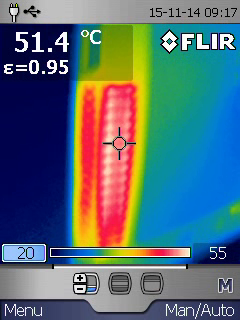

HP Elitebook 745 G2 and HP Elitebook 745 G3
If we take the two HP Elitebook 745s, with the G2 (Kaveri) on the left and the G3 (Carrizo) on the right, the hotspot for both was the vent on the left hand side. As we can see, the G2 part (either by virtue of firmware or the extra 4W in TDP) gives 51ºC compared to 46ºC in the G3. It is also fairly clear that the G2 temperature hotspot is highly spread across the region, whereas the G3’s is more localized.
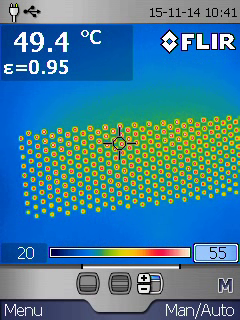
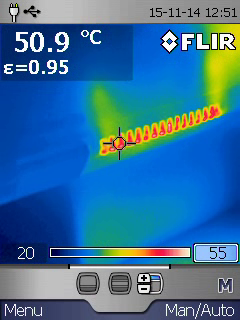

HP Pavilion, Toshiba Satellite and Lenovo Y700
From left to right, here we have the HP Pavilion, Toshiba Satellite and the Lenovo Y700. Both the Pavilion and the Toshiba are between 49-51ºC with the temperature spreading out from the exhaust. Arguably the vent in the Toshiba model is producing a more uncomfortable scenario here. On the far right is the Lenovo Y700, and by virtue of being built to dissipate a 35W APU and similar TDP external graphics card, it barely gets warm at the worst vent. This is shown in the 10 minute shots:
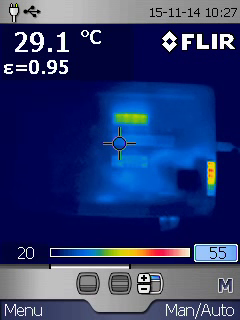
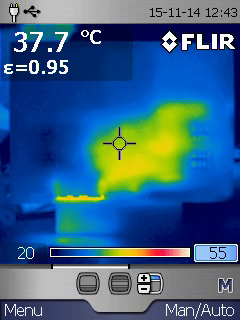

HP Pavilion, Toshiba Satellite and Lenovo Y700
Again, left to right is the HP Pavilion, Toshiba Satellite and the Lenovo Y700. For the Lenovo, this shot is actually taken at 15 minutes and you can barely see much above room temperature. The HP Pavilion on the left has two very localized spots, showing the two vents, and the middle Toshiba has very good or poor heat management, depending on how you look at it. The excess heat is definitely finding its way around a large portion of the base of the laptop, which is good to prevent heat soak, but the problem is that the laptop design doesn’t seem to be getting rid of it like the other two devices. This is perhaps where having a slightly louder but more powerful fan could help, compared to one that won’t push as much air through the device.
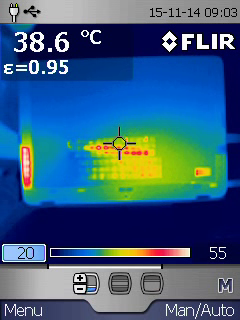
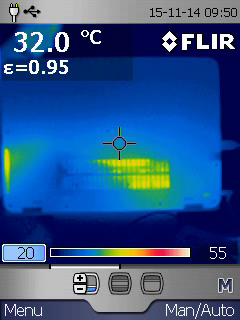
HP Elitebook 745 G2 and HP Elitebook 745 G3
If we go back to the HP Elitebooks (G2 with Kaveri on the left, G3 with Carrizo on the right) we can see a similar situation at the 10 minute mark. The G2 Kaveri system is experiencing a lot of heat soak around the vents, spreading around the bottom of the laptop. The Carrizo system by comparison is on the same road, but much further back. The vents are clearly where the temperature rises the most, which might make it uncomfortable to use, but the Carrizo is certainly doing a better job here.
That’s all well and good for temperature we might feel with the device on the lap, the limiting factor to performance is when we hit that temperature ceiling. We profiled several benchmarks and their temperature characteristics for each of the laptops.
#1: The HP Elitebook 745 G2 (Kaveri, A10 PRO-7350B, 19W)
From the results, it would seem that the G2 has two different temperature modes. In a mode that requires the processing power but is perhaps a trivial set of calculations, the system will set a 60ºC limit:
But when the calculations get more complex and vectorizable, for example transcoding video or ray-tracing, the limit will be raised nearer 70ºC
Even with these limits, in each situation it seems the temperature is actually achieved very quickly, perhaps due to the heat soak as seen in the images above.
#2: The HP Elitebook 745 G3 (Carrizo, PRO A12-8800B, 15W)
While the G3 has an identical design to the G2, we saw above that the Carrizo would seem to have less of an issue with thermal throttling if all was equal. By our results, the footing does seem equal more or less, but the G3 actually seems to have more stringent requirements as to what constitutes as ‘heavy and complex’ to open up the limit beyond 60ºC. So we end up with great graphics like these showing where the temperature limit is kicking in either once with POV-Ray or repeatedly in 3DPM:
But hand it over to PCMark08 and it seems to be all over the place:
With PCMark08 there does seem to be an aim for 55C, but at certain points the system is happy to let the heat soak a little bit before kicking in either the fans or a lower DVFS setting.
#3: The Toshiba Satellite E45DW-C4210 (Carrizo, FX-8800P, 15W)
Based on previous experiences with Toshiba devices, you would forgive me for expecting there to be some issues when it came to temperature related worries. The thermal images above, showing heat soak over the rear of the device, was also poignant. Nonetheless, the figures do the talking, and it turns out that the Toshiba is very aggressive when it comes to temperature limits. There seems to be a blanket 60ºC temperature limit in almost all situations:
There are many occasions when the thermal limit will kick off and a program will let the system rise up a few degrees (particularly in bursty loads) but the system very quickly engages back to get to 60ºC. The only problem the Toshiba has is that the system already seems to be hovering around that temperature before work starts, which might explain why the high frequency modes rarely kick in:
#4: The HP Pavilion 17z-g100 (Carrizo, A10-8700P, 15W)
The HP Pavilion takes the medal for being the biggest device out of the bunch with the lowest frequency Carrizo APU, which usually makes for a good combination of more turbo modes more often without the need to throttle. However, looking at the results, this is far from the case.
The HP Pavilion is actually more restrictive than the previous three already described – no matter what the benchmark, the limit seems to be 55ºC with next to zero ifs or buts.
Even POV-Ray and PCMark08 get struck down immediately or barely even get to 55ºC in the first place. If we look at the frequency histograms, this shows a lot – the Pavilion is rated for a turbo mode of 3.2 GHz, but you would be lucky to even catch a glimmer beyond PCMark08:
All the other benchmarks essentially have 2300 MHz as their regular frequency and mostly clock down to 2100 MHz in temperature dependent situations. This is an odd one – the only compensation one would get out of this is extended battery life (while work isn’t being done) and a less uncomfortable lap (if you happen to be using a 17-inch device on your lap).
#5: The Lenovo Y700 (Carrizo, FX-8800P, 35W) + R9 385MX
Despite the Lenovo being the most powerful and power hungry system here, it probably has the easiest ride on paper. The system design has to be able to get rid of heat when both the APU and GPU are running full steam, which is arguably up to 100W of cooling power. So putting the system through a few tests should be easy enough to invoke the highest frequencies, right?
In practically every benchmark, the system hummed along at 3400 MHz, the top turbo mode. This gives obvious advantages for benchmarking for sure. In most situations the temperature feels unrestrained in the easier benchmarks:
But in PCMark08, it does seem to jump around a fair bit. This means we get a small amount of lower frequencies:
However it is actually the WinRAR test that has most concern. The system keeps the temperature low, pretty much below 40 all the time. This opens up a lot of lower frequencies as a result. Part of this might be to do with memory accesses, as WinRAR is a heavy test on the memory bandwidth.


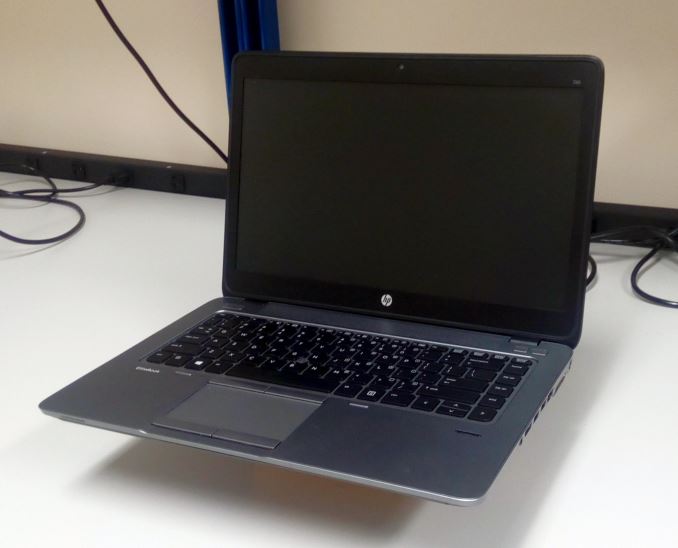
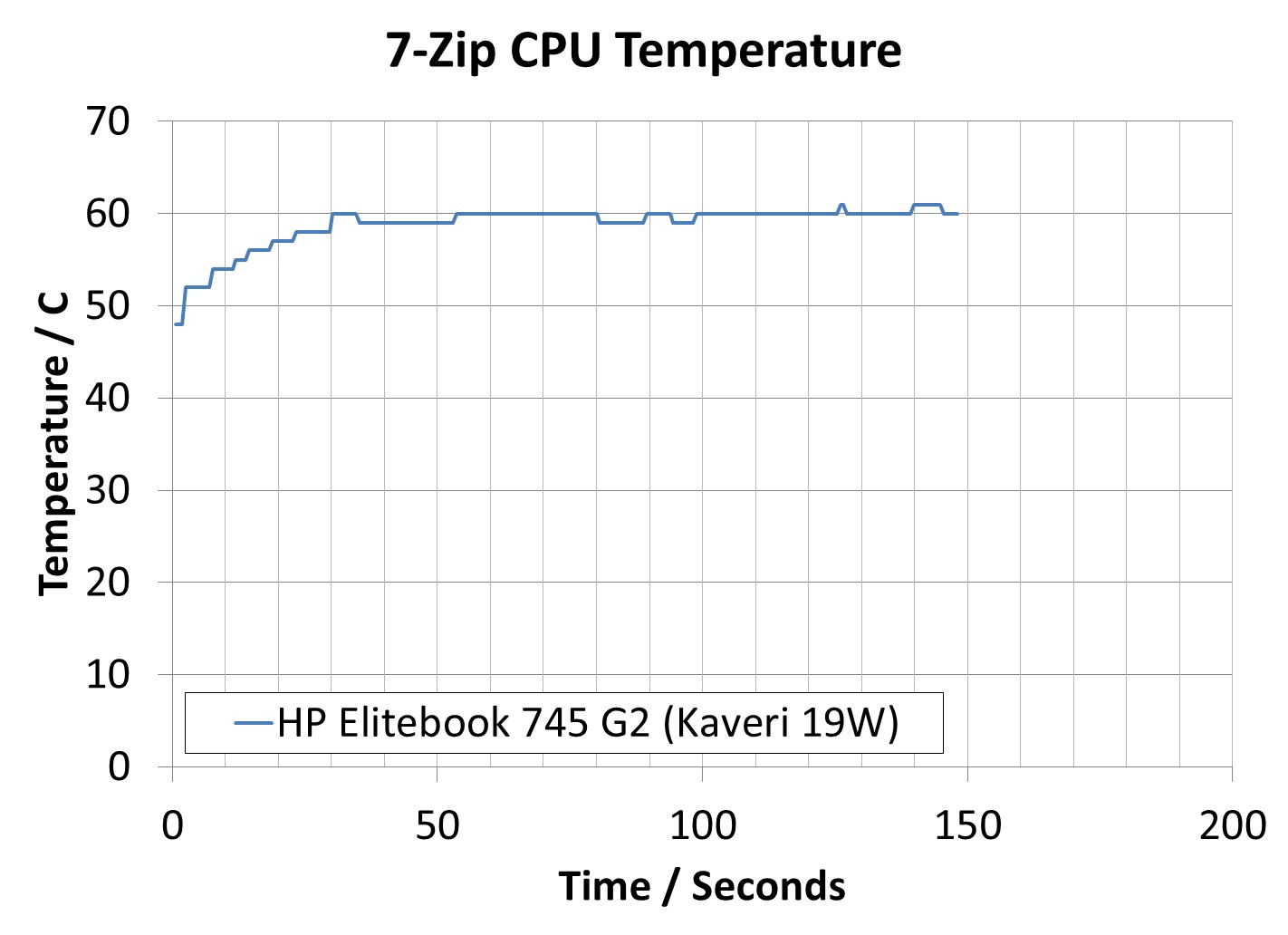


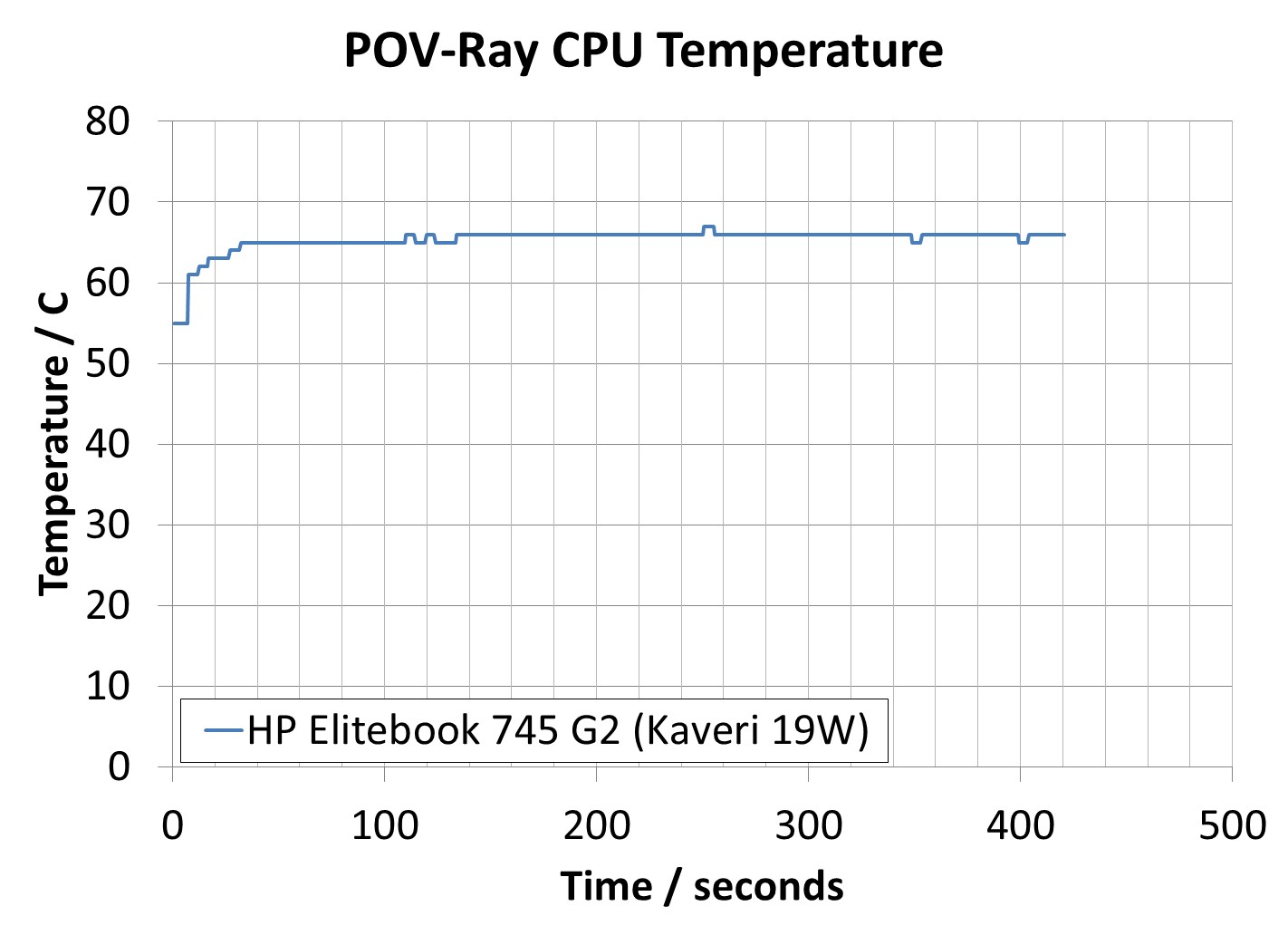
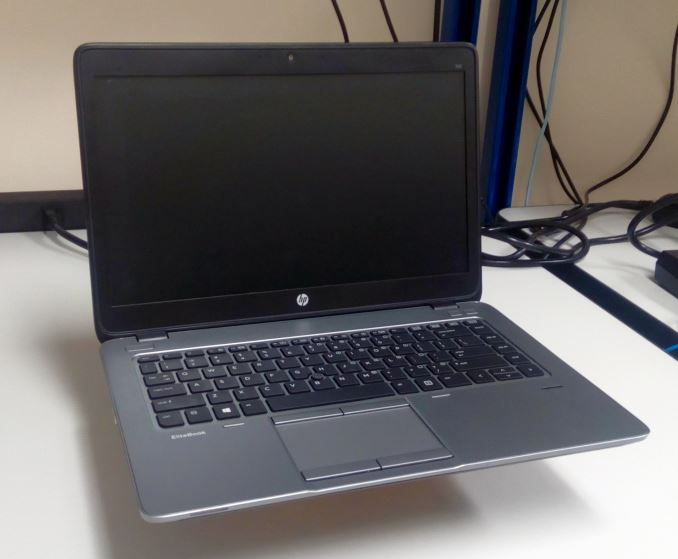
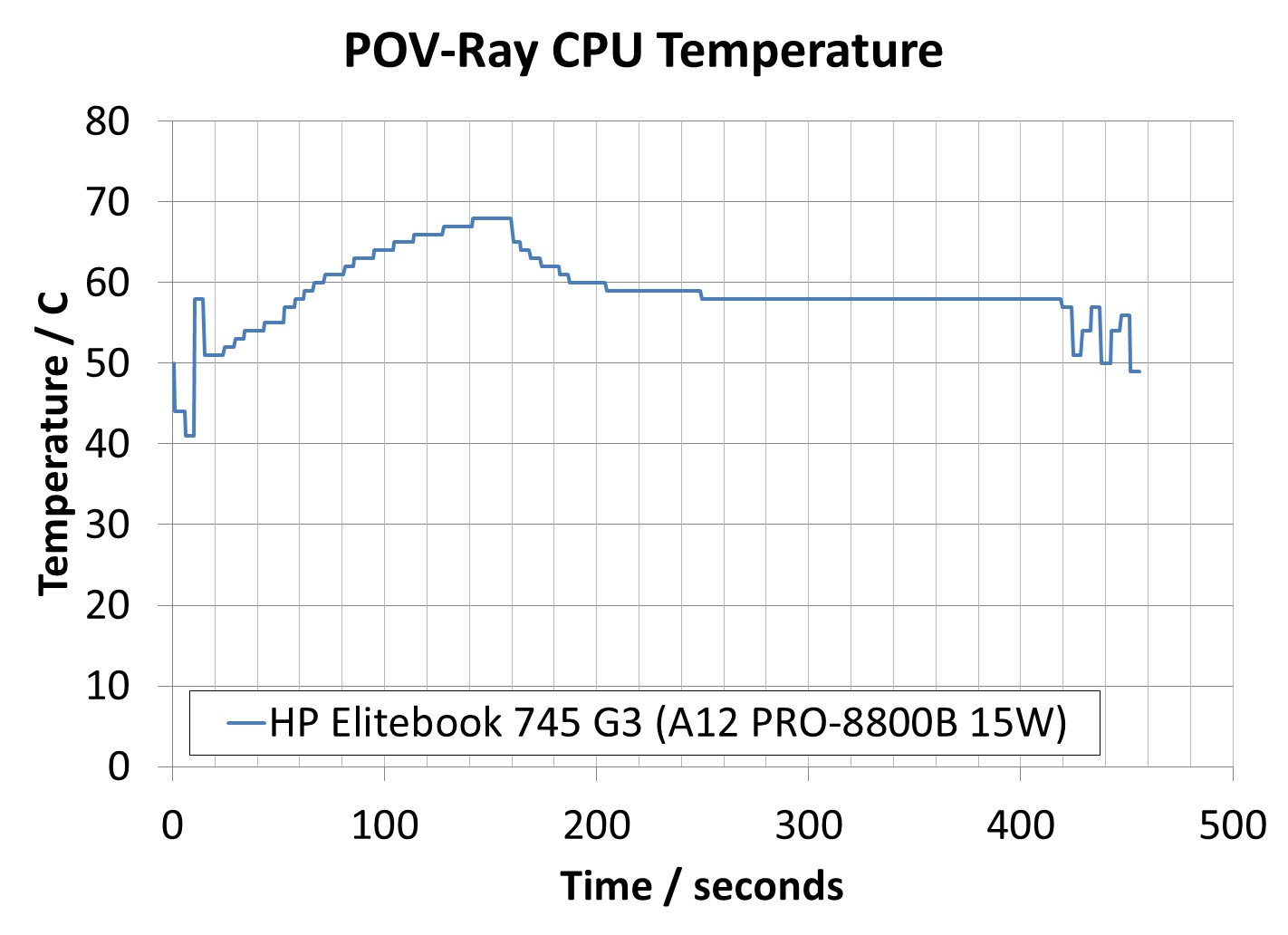
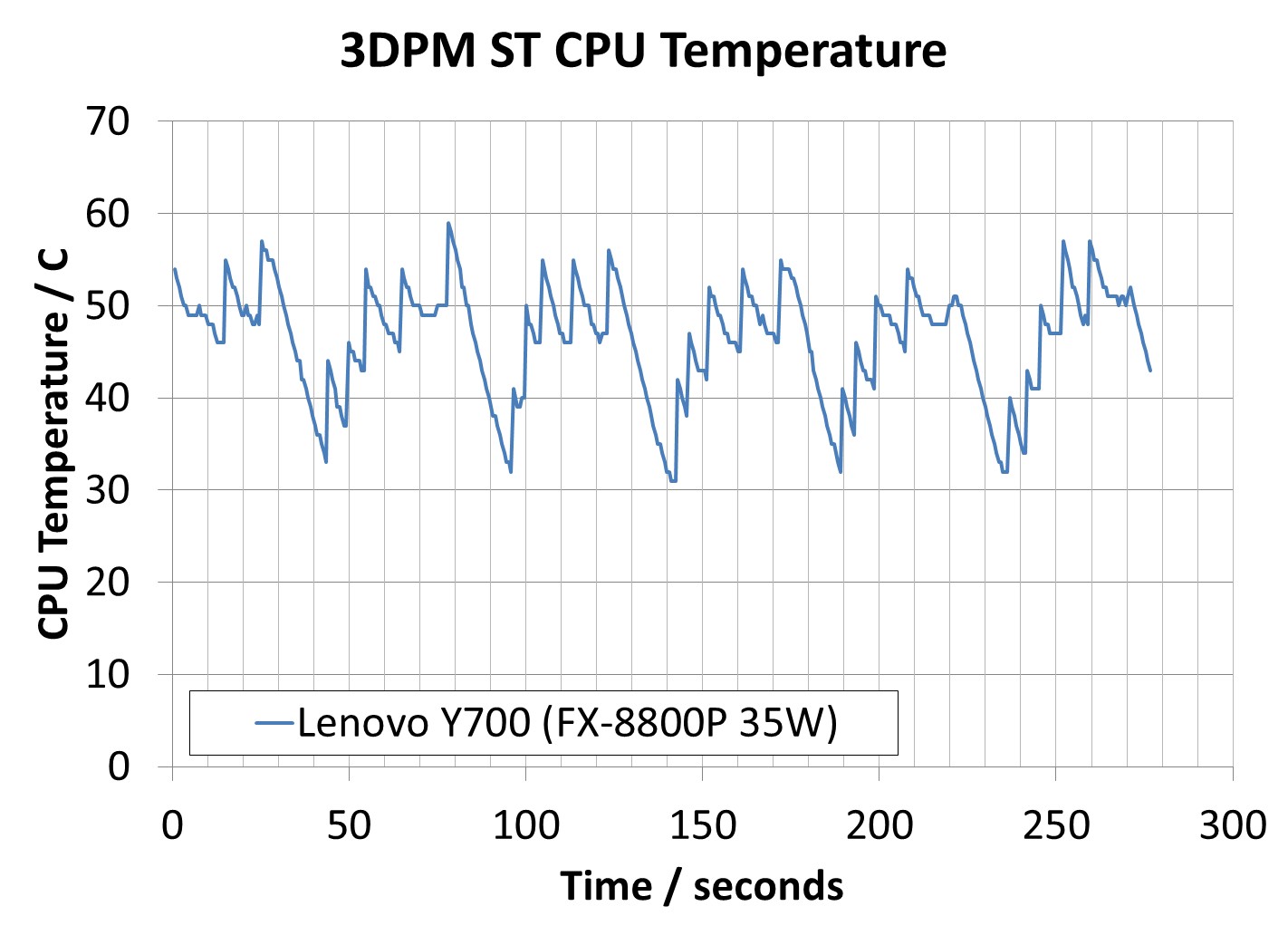
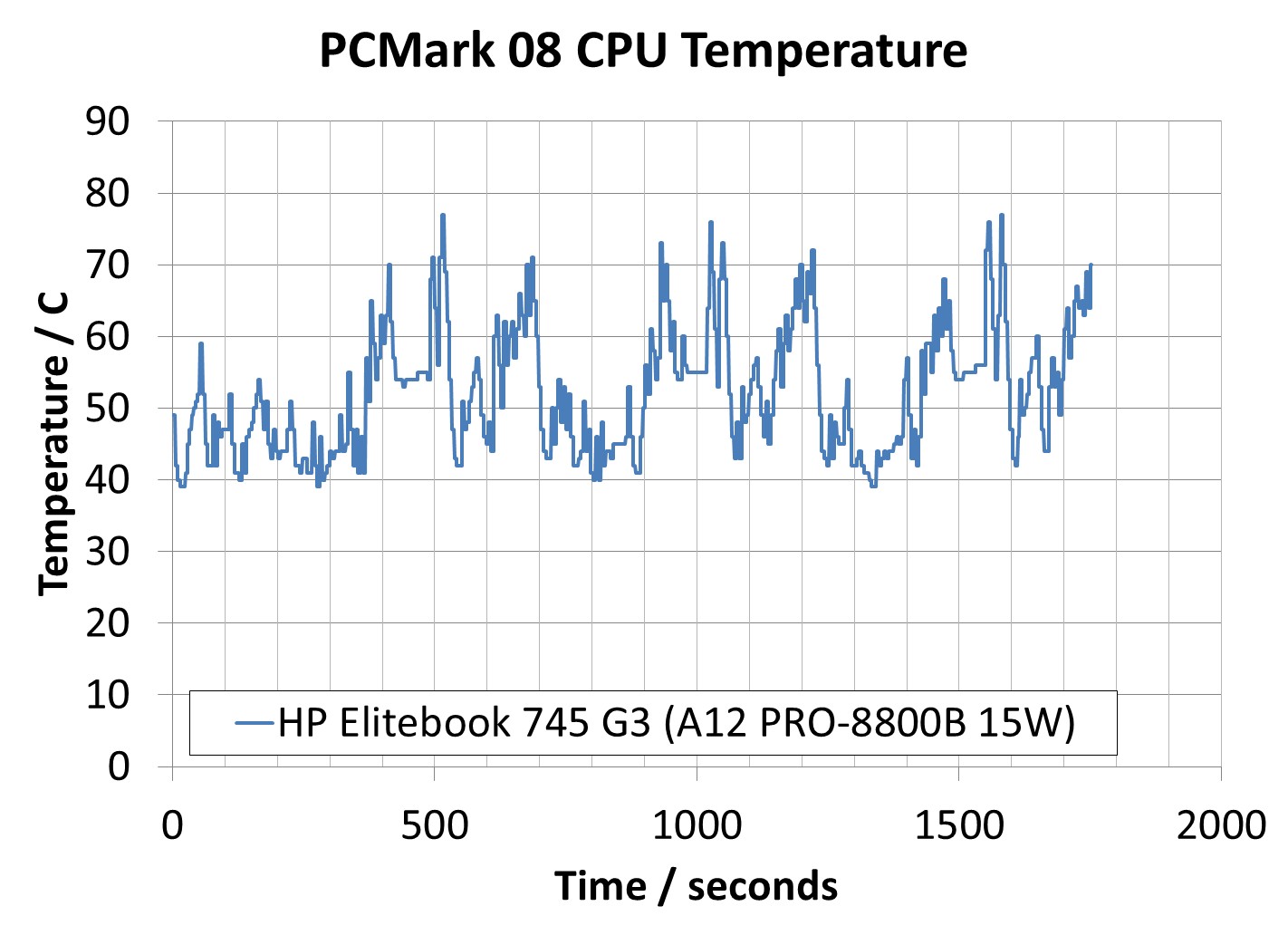
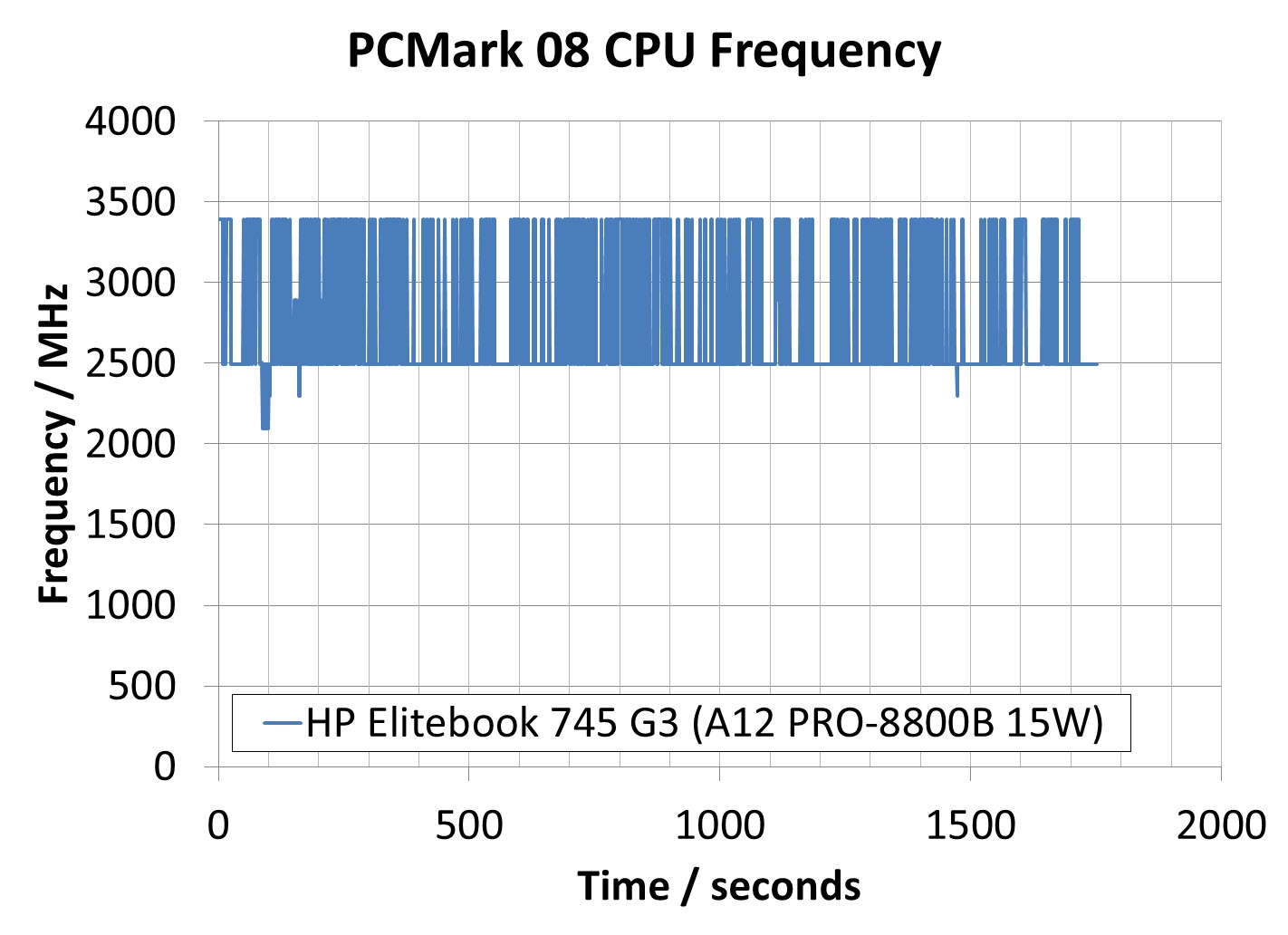
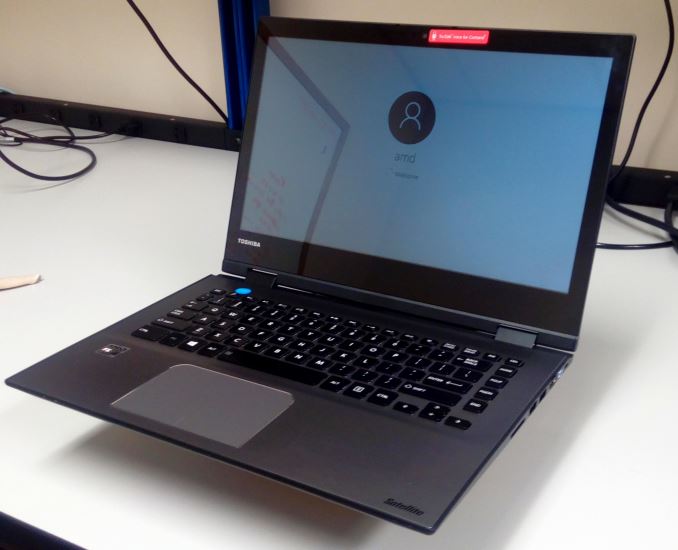
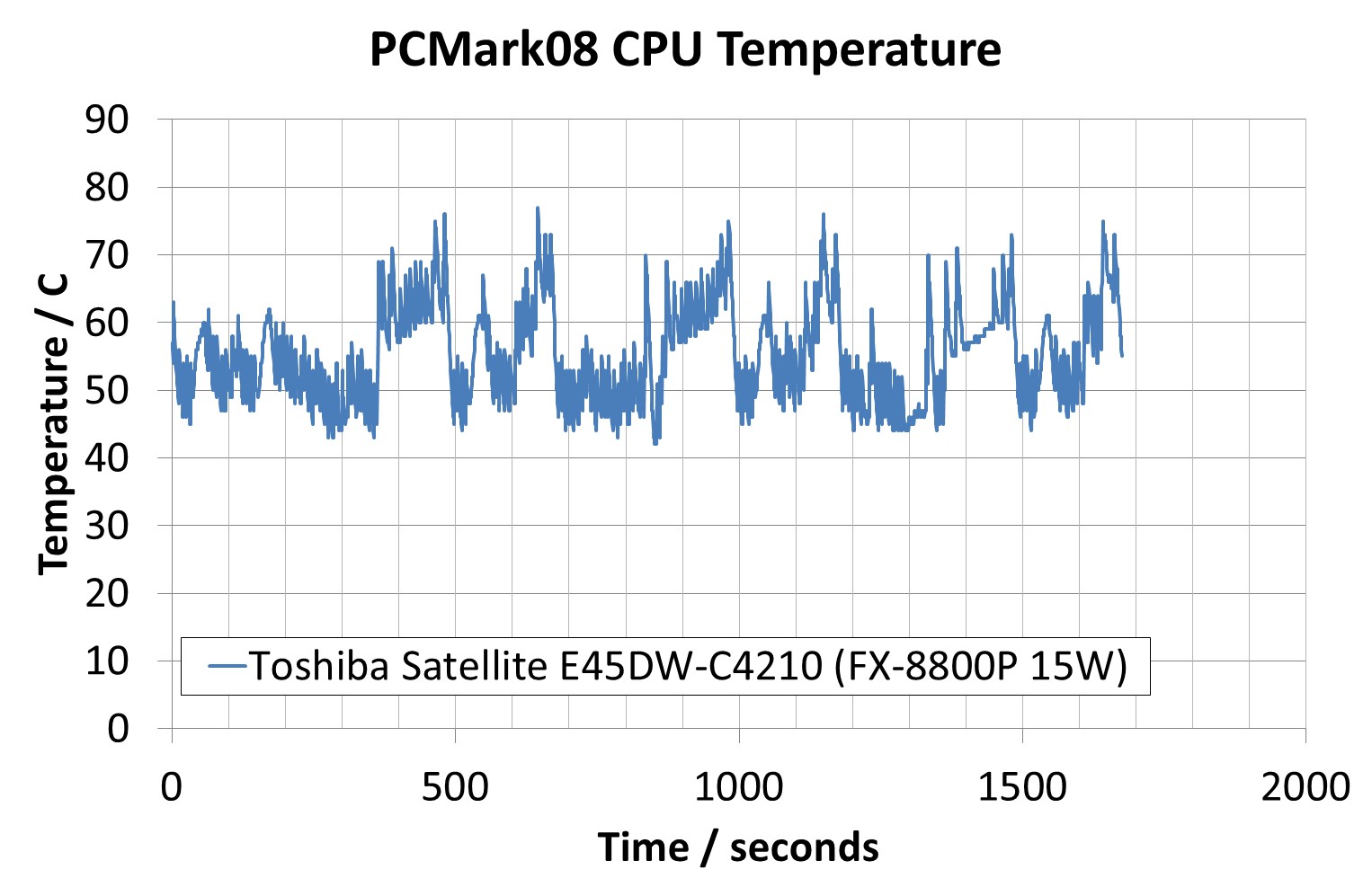

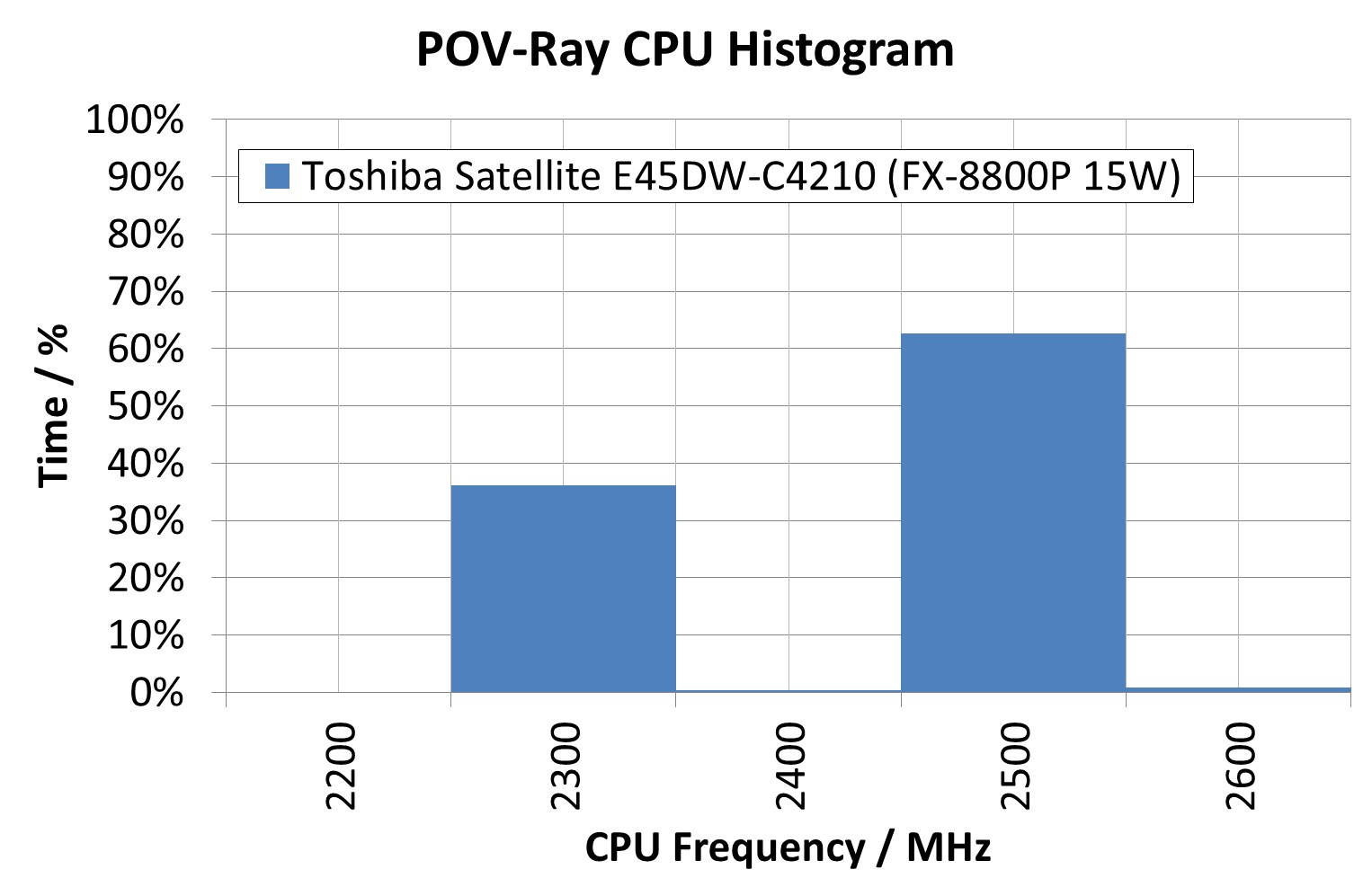
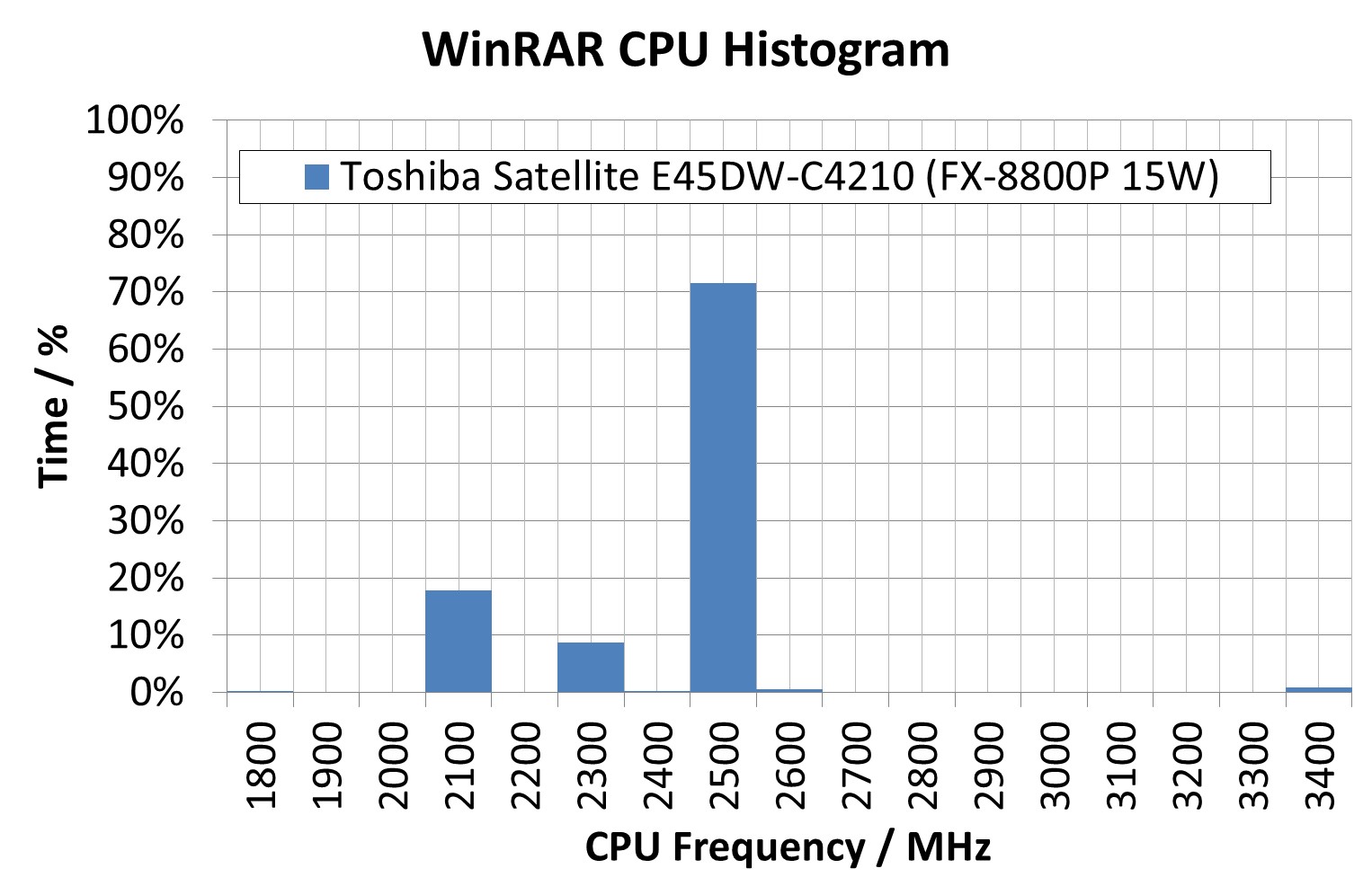
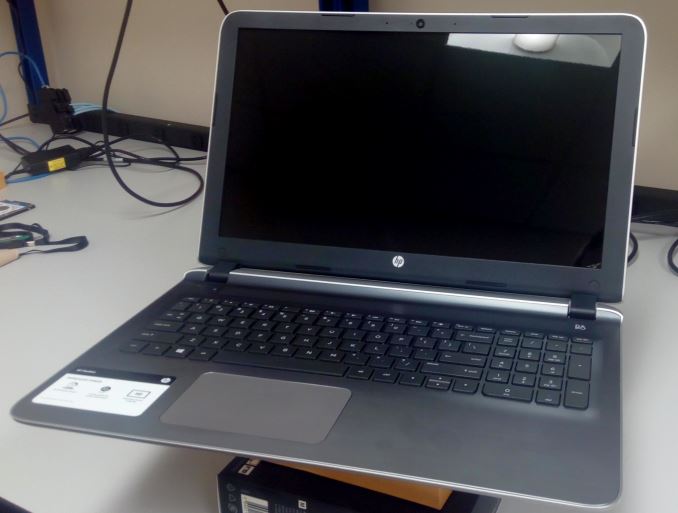
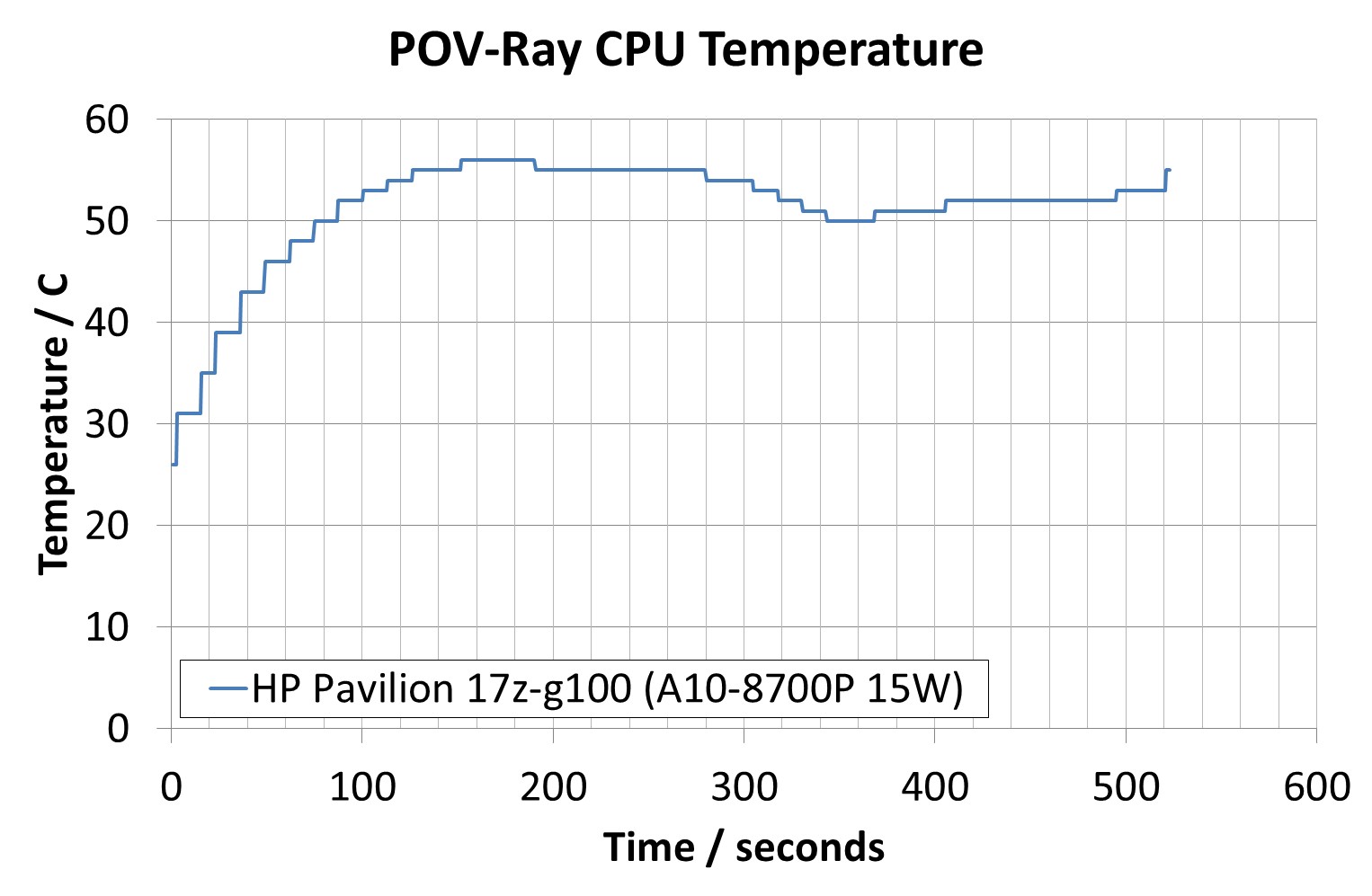

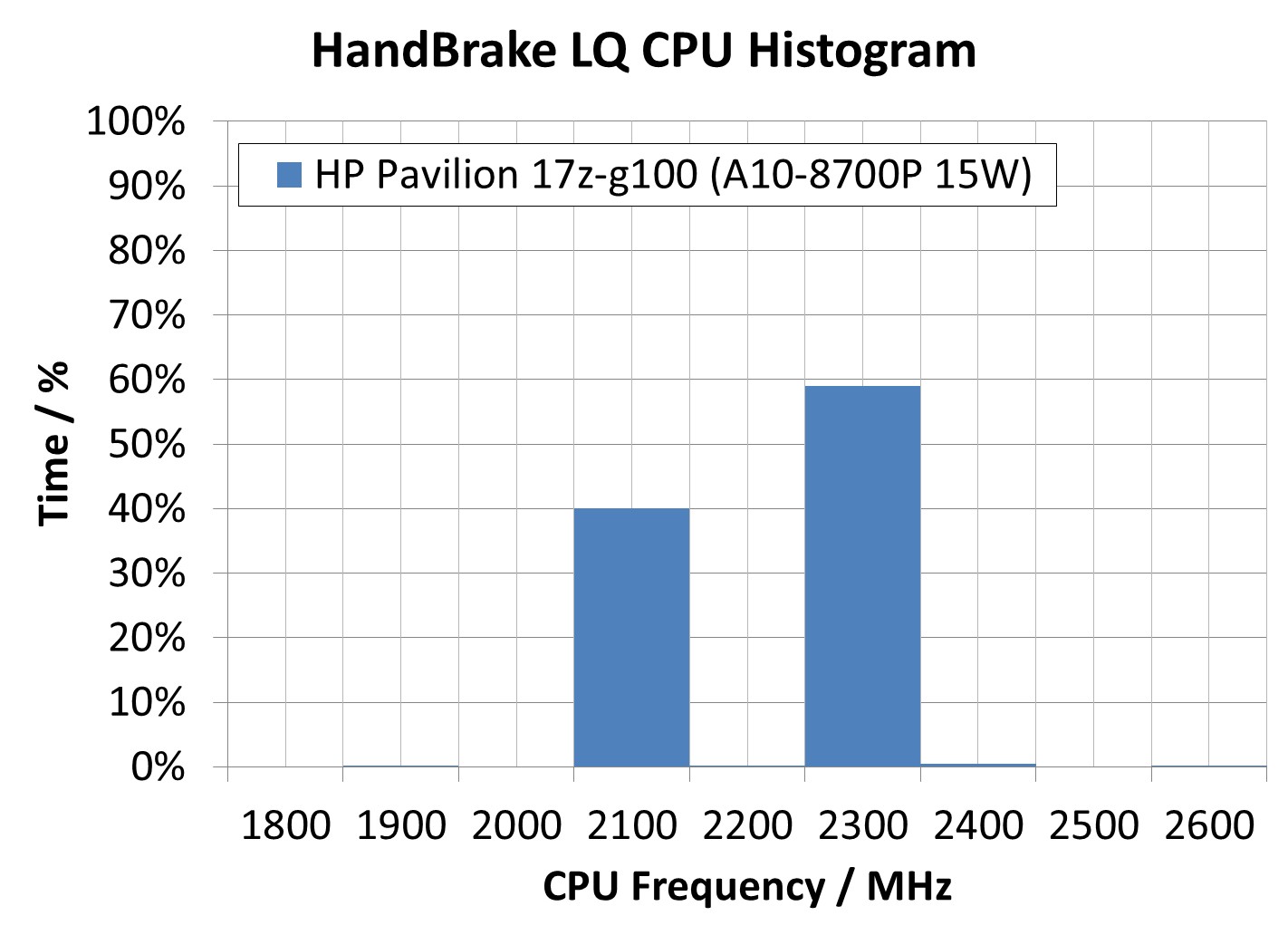
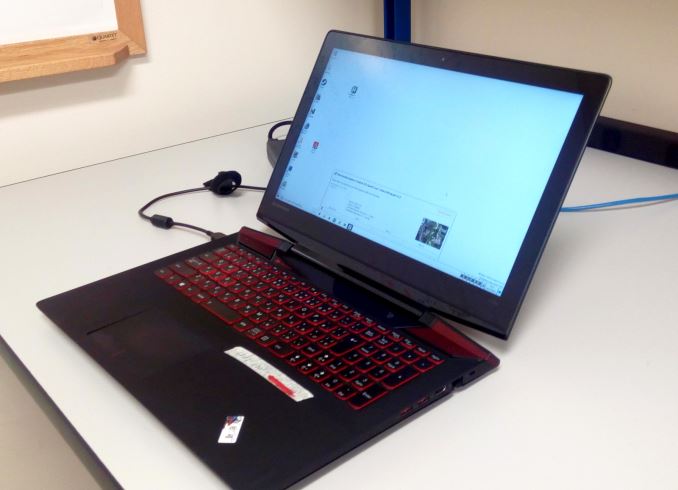

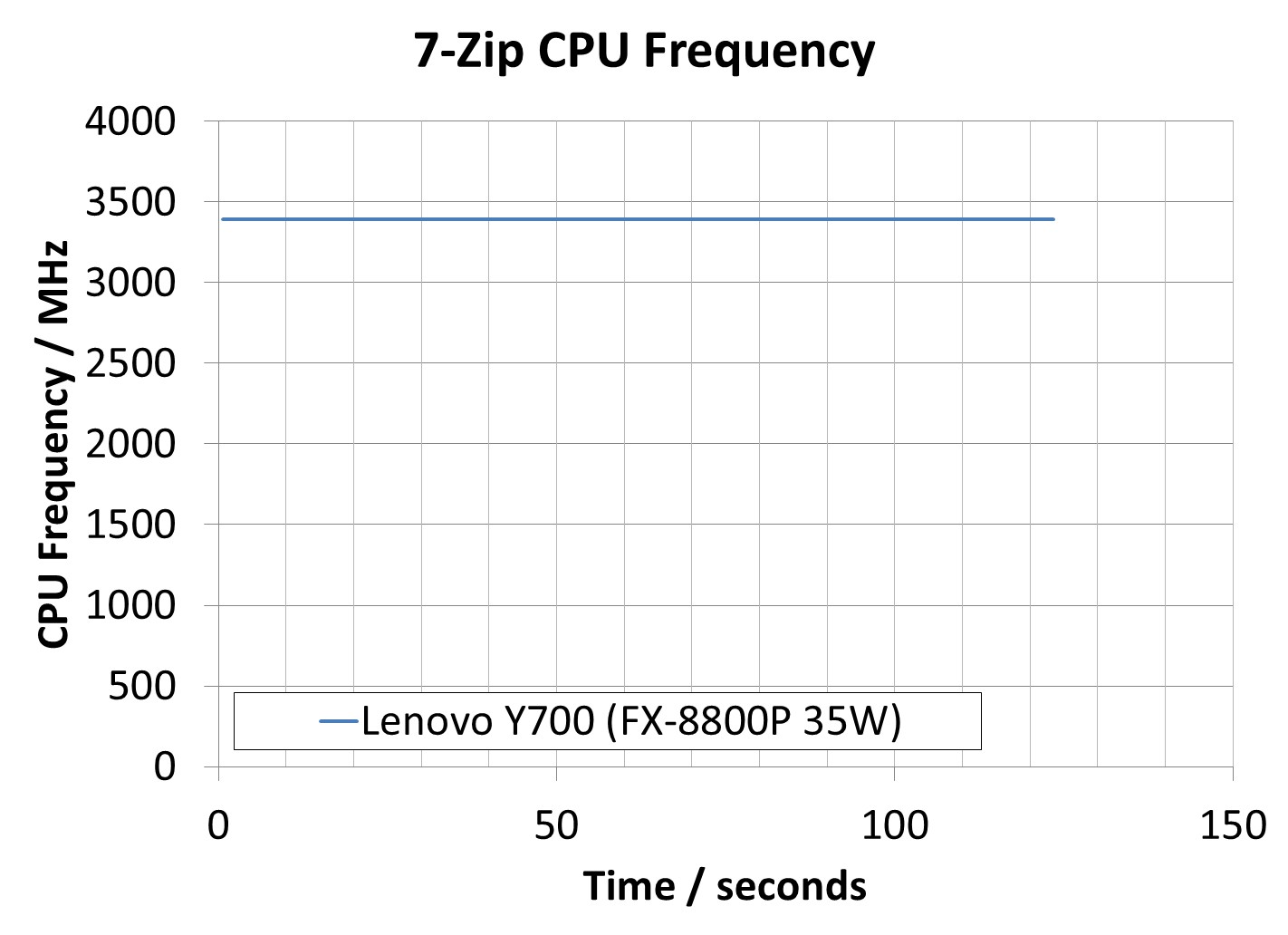

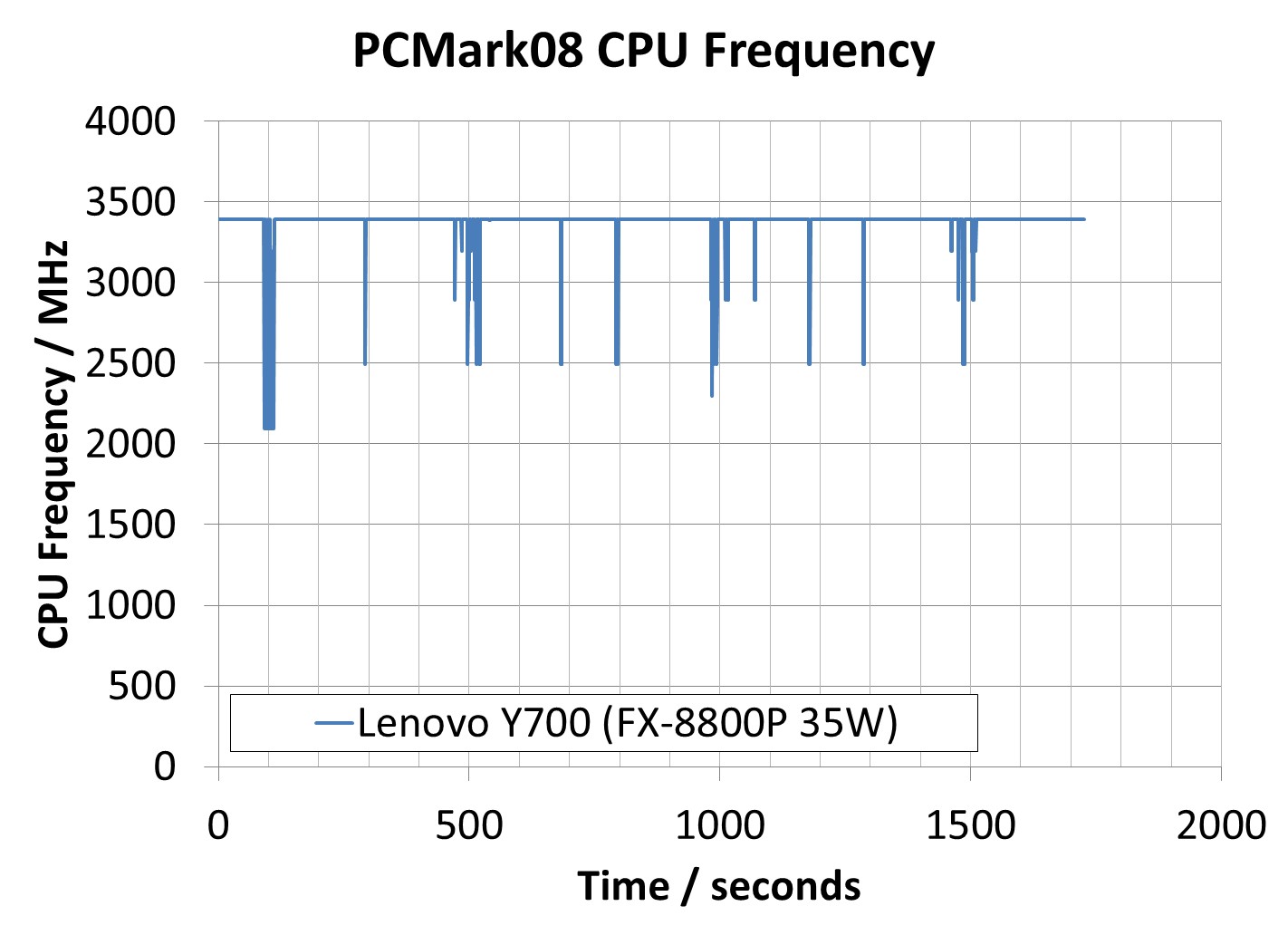
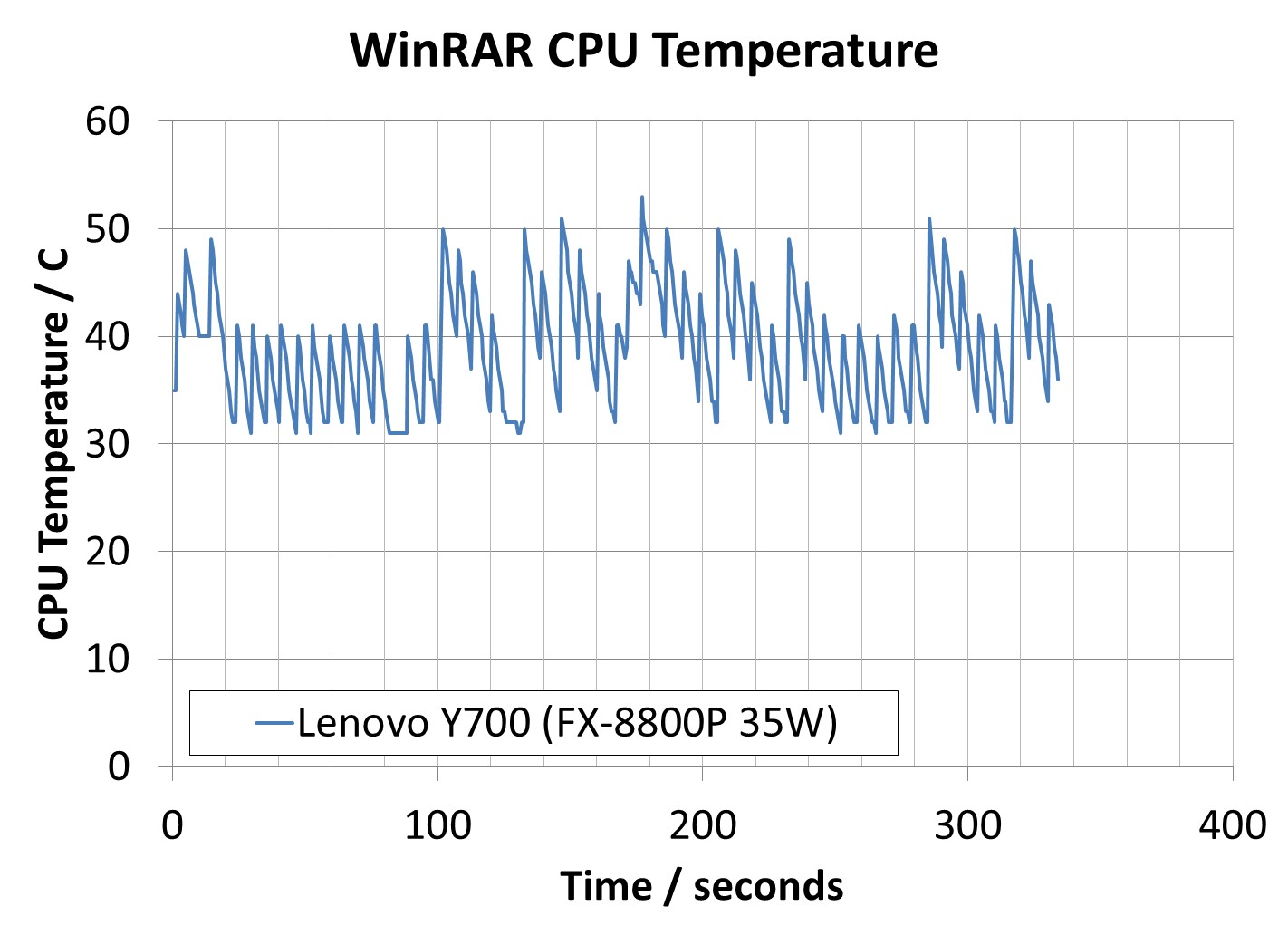
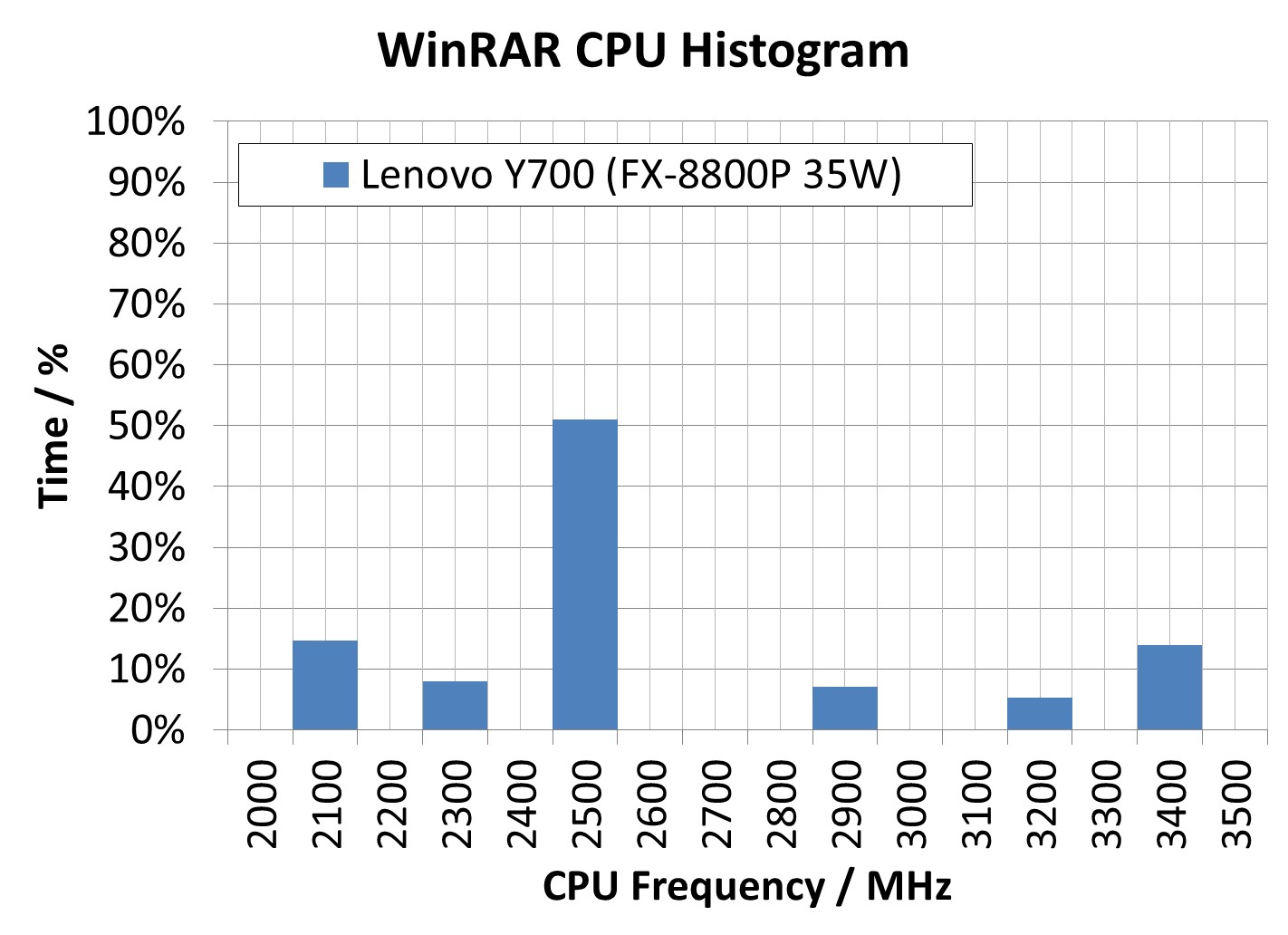








175 Comments
View All Comments
ncsaephanh - Monday, February 8, 2016 - link
Can you guys do a podcast on this article? Would love to hear you guys discuss it and also answer questions/comments on the article.ET - Monday, February 8, 2016 - link
Nice to see a Carrizo article finally, although it's rather disappointing, for example because only single channel was tested.You talked about solutions, here's how I see what AMD and publications like Anandtech need to do (I'm using Carrizo as an example, but it's a lesson for the future):
AMD: When Carrizo is available in a laptop, send one to Anandtech. Immediately. If you have a prototype before that, send that. We want to learn about the chip as quickly as possible, not have to wait months looking for nuggets of information on the web.
Anandtech: Benchmark the hell out of the laptop. If there's single channel with a dual channel option, show a comparative benchmark, but concentrate on dual. We're enthusiasts, we'll install a second DIMM to get better performance. For benchmarks, basic system performance and a plethora of games, and comparison to Intel, plus battery life. Deep dives are nice, but I'd rather have a quick overview of what the system is suitable for, and what kind of gaming it can achieve.
AMD: Desktop first! I know that laptops are where the money is, but desktop is where the enthusiasts are, and if your chip is worth anything, fans and publications like Anandtech will pair it with the fastest memory, configure it with the best TDP, and see what it's really capable of. OEM limitations will not get in the way.
AMD: Fans first! That's pretty much a repeat of the previous point, but AMD, you still have fans, and they are your best customers, not the OEM's or the clueless general public. If you make something that you think is good and you let your fans learn of it and get hold of it, they will tell you what they think and they will tell others. If you leave them in the dark, they will end up losing their enthusiasm.
Anandtech: Follow up on AMD stuff. It may be hard to get the latest AMD chips if AMD isn't helping, but at least let us know you're on it. An occasional news item telling us that you've tried to get some laptops for testing or whatnot will tell us that you're on it, and hopefully shame AMD and the OEM's enough to get a move on.
Personally, I would likely have bought a Carrizo system if there was one of similar size to my old Thinkpad X120e (which I still use, even if I'm not that happy with its speed). I might have bought a Carrizo for my HTPC if I could and I knew it provided decent enough performance.
sofocle10000 - Monday, February 8, 2016 - link
I just signed in to state that Asus had nice business/multimedia notebooks (I used N60DP/N56DP and I actually use an N551ZU - all based on AMD), and although my actual N551ZU is only based on the top of the line Kaveri, it is an exceptional machine for normal use/light gaming...Customers play a big part in the AMD problem, but if there were more incentives (take my current N551ZU, which is a great notebook for ~750-850 $, and if configured with an SSD, you could hardly tell it apart most of the time from the Intel i5H/i7QH + GTX 950M variants), not only a great price, but a better build quality, display, sound system the the market average, some of them would actually pay more attention to the AMD.
The OEM's should have a more defined bottom line for the AMD notebooks - were dual channel memory and a better display, a hybrid SSHD or a SSD are a must, especially for the models in the upper part of the price range 400-700 $...
dragosmp - Monday, February 8, 2016 - link
@Ian - great article, really a good example of investigative journalism. I'm happy this kind of articles are being revived, but being a reader of Tom's I see where this may be coming from.As the "guy that says what laptop/phone to buy" to my family and friends I have to say your findings and conclusions speak to me very clearly - AMD has a system-problem, not so much a CPU-problem (though some may argue differently). AMD chips are fed into cheap looking/feeling PCs with far too many corners cut, but this is how under 700$ market looks like. Could AMD's OEMs sell a 600$ 13" PC to compete with the CoreM UX305? I think not, simply because AMD's CPUs (who consume more) need thicker chassis with stronger cooling and a beefier battery and that costs money - so there's less available for the UX; even if the OEM accepted lower margins on the AMD PC, or AMD to sell the CPU at bargain prices, that design compared to the UX305 would be thicker and likely noisier.
If Zen is good, I could see it in a Mac as Apple has a history of doing good software. Or AMD should build their own surface line and set an example of what can be done.
Gunbuster - Monday, February 8, 2016 - link
People buy the cheapest $300 laptop they can get or something premium. Who are they targeting with these mid-rangers?farmergann - Tuesday, February 9, 2016 - link
Wife uses her Y700 for school and a few hours of photo editing every week. Exactly what she wanted. This article did a worthless job of representing the actual Y700 w/fx8800p you can pick up at Best Buy for $665-830. Everything is fantastic about it save for the TB HDD which I immediately replaced with a Samsung 850 Pro I had laying around.Somehow, this "investigative" nonsense missed the fact the U.S. Y700 has a superb little IPS screen with Freesync to go along with a surprisingly (truly) good sound system and -despite the author's claim- dual channel ram. Just for grins I've played BF3 and a few other games - none of which had issues. Great low/mid-range laptop with plenty of chops.
every1hasaids - Tuesday, February 9, 2016 - link
Nope, the US model is absolute garbage. They skimped on the VRMs and the laptop subsequently throttles in moderately intensive CPU tasks. Example, try running Cities: Skylines with a decent sized city and tell me that it doesn't stutter after about 20 seconds of play and every 5 seconds or so after that. The stutters which coincide with the CPU being utilized near 100% and the frequency dropping per resource monitor and Afterburner all the way down to 1.6ghz... Also I don't know what you're talking about with the Freesync capability, I could not get it to work after reading elsewhere that it may be possible.The main issue with a product like the Y700 is that the intel variant is only a couple hundred bucks more and you get a genuine quad core with HT, dual channel DDR4-2133 and comparable discreet graphics. Oh, and it has no trouble with voltage supply. Not to mention that the m.2 interface is PCI-E as opposed to SATA on the AMD model. It just doesn't make sense to purchase a far inferior product for only $200 less at the price point these models occupy.
farmergann - Thursday, February 11, 2016 - link
Cities: Skylines? LOL, that's about as rich as whining about Starcraft 2 performance on an FX Octacore - what were you expecting exactly? For people not looking to shove a laughably CPU bound title down a 35W laptop's throat, the FX8800p with user installed SSD is a far better choice, sorry guy.Peichen - Monday, February 8, 2016 - link
Wow, that's wasting a lot of time and words reviewing a product no one will buy. AMD needs to exist to keep the cheap Intel stuff dirt cheap but I don't feel anyone should waste time reviewing AMD CPU products. 10 years of marketing hype and under-delivery means AMD is actually slower than ever compares with Intel.I bought 2 AMD CPU over the last 6/7 years and frankly I wish I spend more buying Intel because I wouldn't have to spend time and money as often upgrading the CPU.
Danvelopment - Monday, February 8, 2016 - link
The way I see it, AMD needs to stop comparing themselves with themselves and needs to compare themselves with the competition. People don't understand the improvements if they aren't involved with the predecessor.They produce a reasonable product that performs at 60-80% of the competition at 50% of the price.
Good designs are produced for the competition, that could fundamentally have their parts, and they're losing on the design front.
And strangely, for similar products the AMD machines are the same cost, even though the difference is the chip (at halfish the price).
Can they not work to develop an easier transition method for OEM's to produce this-or-that designs that allow end users to pick AMD or Intel during the selection process. Tier them like Dell does for the various Intel processors but have them consistently show up as the cheapest option $100 off a $500 laptop is a decent drop and if the chip and PCB is $150 cheaper to produce the OEM still wins).
Differentiating the product creates too many variables people don't understand, and creates the issue above, CPU brand aversion on entire product stacks with no common ground.
I'd say take a long, hard look at current machines, and develop a method of getting their chips into them as an option, without OEMs designing a product from the ground up.
I'd certainly consider AMD if I could just select it as an option that knocks $100 off on the low cost tier laptop in my workplace.